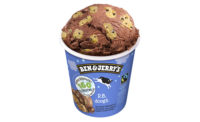Ice cream is among the largest supermarket food categories, one of only 10 with double-digit billion dollar sales, according to Packaged Facts, Rockville, Md.
Even so, results from a survey conducted by Cumberland Farms, Framingham, Mass., revealed that 95% of respondents indulge in ice cream year-round, regardless of the season. When it comes to the time of day, 79% of respondents agree that the prime time to eat ice cream is during the evening between 5-11 p.m. And, nearly 60% of respondents eat ice cream out of a dish or cone vs. just digging in straight from the carton.
Likewise, new research from Mintel, Chicago, reveals that while nine in 10 (92%) consumers have purchased frozen treats in the past six months, only one quarter (22%) are buying less. And, while just 11% of consumers considered portion control as a purchase factor in 2013, today, one-third (32%) report that they purchase single-serve frozen treat packages.
Appealing to changing consumer taste preferences, variety is the name of the ice cream game, as more than one-quarter (27%) of consumers have purchased a variety pack in the past six months. However, despite the desire to experience various flavors, consumers primarily buy products that feature a single flavor (53%). Adding to the appeal of single-serving and variety packs, more than one-quarter (27%) of consumers typically have more than one type of frozen treat/flavor in their freezer at one time.
Yogurt drinks make quite the entrance
Mintel research also reveals that sales of yogurt drinks have grown a healthy 62% in the five years (2011-2016), with the spoonable yogurt segment accounting for the majority of sector sales.
Yogurt is among America’s Top 5 breakfast items, according to the report, with just under half (45%) of U.S. consumers purchasing yogurt at retail for breakfast; however, cereal (65%), fruit (55%), bread (55%) and breakfast meals (48%) take top billing.
When it comes to eating occasions, 93% of yogurt/yogurt drinks are consumed for breakfast. But, the market appears to be gaining ground in the snacking arena. More than nine in 10 (93%) yogurt/yogurt drink users say that they consume these products as a snack. Mintel research reveals that more consumers are choosing yogurt as a snack today than in previous years, as 84% choose yogurt as a morning or afternoon snack (respectively), up from 37% who chose it as a morning snack and 41% who snacked in the afternoon in 2014.
Cheese please
On the other hand, growth in the refrigerated dairy case is largely due to the influx of cheese demand.
In fact, according to Hoovers, Austin, Texas, U.S. dairy manufacturers produce about 11.5 billion pounds of cheese each year, while the average American consumes more than 35 pounds of cheese per year — an increase of more than 20% in the last two decades.
Accession of M&As
Many dairy processors have grown rapidly over the last several years due to purchasing local dairies, merging with dairy co-ops or creating more efficient production and distribution systems. In fact, deal making will rise once again in 2017, accompanied by a rebound in valuations, according to A.T. Kearney, Chicago.
For instance, as part of its expansion efforts, Hiland Dairy Foods, Springfield, Mo., announced plans to acquire the ice cream, dairy and water manufacturing assets from Brookshire Grocery Co.
Midfield Group, Australia, and Louis Dreyfus Co. Dairy Asia Pte Ltd., a Netherlands-based wholly owned subsidiary of Louis Dreyfus Co. Asia, entered into a joint venture for the construction, development and management of a dairy processing plant in Penola, South Australia.
Vermont dairy producers formed the Vermont Dairy Producers Alliance, Montpelier, Vt., to increase the voice of dairy farming in both the regulatory and legislative arenas.
Prairie Farms Dairy, Carlinville, Ill., and Swiss Valley Farms, Davenport, Iowa, entered into a merger agreement.
And, Continental Dairy Facilities, LLC, Coopersville, Mich., and Fairlife LLC, Chicago, announced a collaborative project to propose additional on-site wastewater treatment capacity at their 100-acre dairy processing plant in Coopersville, Mich.
Click here to view market trends for this category.
To learn more about these and other trends and charts, go to http://bit.ly/2qkpeuU.




